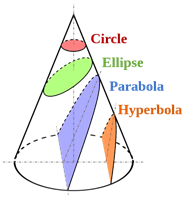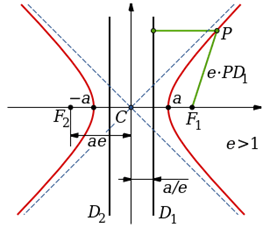Difference Between Hyperbola and Ellipse
Table of Contents
Hyperbola vs Ellipse
When a cone is cut at different angles, different curves are marked by the edge of the cone. These curves are often called the conic sections. More precisely, a conic section is a curve obtained by intersecting a right circular conic surface with a plane surface. At different angles of intersection, different conic sections are given.
Both hyperbola and ellipse are conic sections, and their differences are easily compared in this context.
More about Ellipse
When the intersection of the conic surface and the plane surface produces a closed curve, it is known as an ellipse. It has an eccentricity between zero and one (0<e<1). It can also be defined as the locus of the set of points on a plane such that the sum of the distances to the point from two fixed points remains constant. These two fixed points are known as the ‘foci’. (Remember; in elementary math classes the ellipses are drawn using a string tied to two fixed pins, or a string loop and two pins.)
The line segment passing through the foci is known as the major axis, and the axis perpendicular to the major axis and passing through the center of the ellipse is known as the minor axis. The diameters along each axis are known as the transverse diameter and the conjugate diameter respectively. Half of the major axis is known as the semi-major axis, and half of the minor axis is known as the semi-minor axis.
Each point F1 and F2 are known as the foci of the ellipse and lengths F1 + PF2 = 2a , where P is an arbitrary point on the ellipse. Eccentricity e is defined as the ratio between the distance from a focus to the arbitrary point ( PF2 ) and the perpendicular distance to the arbitrary point from the directrix (PD). It is also equal to the distance between the two foci and the semi-major axis: e = PF/PD = f/a
The general equation of the ellipse, when the semi-major axis and the semi-minor axis coincide with the Cartesian axes, is given as follows.
x2/a2 + y2/b2 = 1
The geometry of the ellipse has many applications, especially in physics. The orbits of the planets in the solar system are elliptical with the sun as one focus. The reflectors for antennae and acoustic devices are made in elliptical shape to take advantage of the fact that any emission form a focus will converge on the other focus.
More about Hyperbola
The hyperbola is also a conic section, but it is open ended. The term hyperbola is referred to the two disconnected curves shown in the figure. Rather than closing like an ellipse the arms or the branches of the hyperbola continue to the infinity.
The points where the two branches have the shortest distance between them are known as the vertices. The line passing through the vertices is considered as the major axis or the transverse axis, and it’s one of the principal axes of the hyperbola. The two foci of the parabola also lie on the major axis. The midpoint of the line between the two vertices is the center, and the length of the line segment is the semi-major axis. The perpendicular bisector of the semi-major axis is the other principal axis, and the two curves of the hyperbola are symmetric around this axis. The eccentricity of the parabola is greater than one; e > 1.
If the principal axes are coinciding with the Cartesian axes, the general equation of the hyperbola is of the form:
x2/a2 – y2/b2 = 1,
where a is the semi-major axis and b is the distance from the center to either focus.
The hyperbolas with open ends facing the x-axis are known as the east-west hyperbolas. Similar hyperbolas can be obtained on the y axis too. These are known as the y-axis hyperbolas. The equation for such hyperbolas takes the form
y2/a2 – x2/b2 = 1
What is the difference between Hyperbola and Ellipse?
• Both ellipses and hyperbola are conic sections, but the ellipse is a closed curve while the hyperbola consists of two open curves.
• Therefore, the ellipse has finite perimeter, but the hyperbola has an infinite length.
• Both are symmetrical around their major and minor axis, but the position of the directrix is different in each case. In the ellipse, it is lying outside the semi-major axis while, in hyperbola, it lies in the semi-major axis.
• The eccentricities of the two conic sections are different.
0 <eEllipse < 1
eHyperbola > 0
• The general equation of the two curves looks the same, but they are different.
• Perpendicular bisector of the major-axis intersects the curve in the ellipse, but not in the hyperbola.
(Images source: Wikipedia)
ncG1vNJzZmivp6x7pbXFn5yrnZ6YsqOx07CcnqZemLyue8OinZ%2Bdopq7pLGMm5ytr5Wau2602Kmcq5qfoa5urc2dZK%2BrXZq5rbXPrJxo


